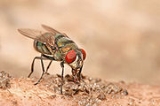
Chrysomya albiceps
Encyclopedia
Chrysomya albiceps is a species belonging to the blow fly family, Calliphoridae. It is of great medical and sanitary importance, being associated with myiasis
in Africa and America although it plays a more significant role as a predator of other diptera
n larvae. The species is also of importance in forensic science and forensic entomology
because it is the first insect
to come in contact with carrion
due to their ability to smell dead animal matter from up to ten miles (16 km) away. C. albiceps belongs to the same genus as the other myiasis-causing flies Chrysomya bezziana
and Chrysomya putoria
.
by some authorities.The two species have a similar biology and the morphological differences are slight (prostigmatic
bristle present in C. albiceps absent in C. rufifacies (but not all rufifacies so this character is unreliable)).There are minor differences in larval morphology.The taxonomy of C. rufifacies is therefore not completely clear, and its relation to C. albiceps has not been fully determined.
Myiasis
Myiasis is a general term for infection by parasitic fly larvae feeding on the host's necrotic or living tissue. Colloquialisms for myiasis include flystrike, blowfly strike, and fly-blown. In Greek, "myia" means fly....
in Africa and America although it plays a more significant role as a predator of other diptera
Diptera
Diptera , or true flies, is the order of insects possessing only a single pair of wings on the mesothorax; the metathorax bears a pair of drumstick like structures called the halteres, the remnants of the hind wings. It is a large order, containing an estimated 240,000 species, although under half...
n larvae. The species is also of importance in forensic science and forensic entomology
Forensic entomology
Forensic entomology is the application and study of insect and other arthropod biology to criminal matters. It is primarily associated with death investigations; however, it may also be used to detect drugs and poisons, determine the location of an incident, and find the presence and time of the...
because it is the first insect
Insect
Insects are a class of living creatures within the arthropods that have a chitinous exoskeleton, a three-part body , three pairs of jointed legs, compound eyes, and two antennae...
to come in contact with carrion
Carrion
Carrion refers to the carcass of a dead animal. Carrion is an important food source for large carnivores and omnivores in most ecosystems. Examples of carrion-eaters include vultures, hawks, eagles, hyenas, Virginia Opossum, Tasmanian Devils, coyotes, Komodo dragons, and burying beetles...
due to their ability to smell dead animal matter from up to ten miles (16 km) away. C. albiceps belongs to the same genus as the other myiasis-causing flies Chrysomya bezziana
Chrysomya bezziana
Chrysomya bezziana, also known as the Old World screwworm fly or screwworm, is an obligate parasite of mammals. Obligate parasitic flies require a host to complete their development. Named to honor the Italian entomologist Mario Bezzi, this fly is widely distributed in Asia, tropical Africa, India,...
and Chrysomya putoria
Chrysomya putoria
Chrysomya putoria, an Old World screw-worm fly, or screw-worm for short, is a species of parasitic fly lay larvae in the living tissue of warm-blooded animals....
.
Taxonomy
Chrysomya albiceps is considered conspecific with Chrysomya rufifaciesChrysomya rufifacies
Chrysomya rufifacies is a species belonging to the blow fly family, Calliphoridae, and is most significant in the field of forensic entomology due to its use in establishing or altering postmortem intervals. The common name for the species is the hairy maggot blow fly, and it belongs to the genus...
by some authorities.The two species have a similar biology and the morphological differences are slight (prostigmatic
Prostigma (Diptera)
The Prostigma , Stigma Anteriore or Anterior Spiracle is the anterior of the two pairs of spiracles opening on the pleura. The mesothoracic pair is located between the pro- and mesothorax and the metathoracic pair between the meso- and metathothorax...
bristle present in C. albiceps absent in C. rufifacies (but not all rufifacies so this character is unreliable)).There are minor differences in larval morphology.The taxonomy of C. rufifacies is therefore not completely clear, and its relation to C. albiceps has not been fully determined.

